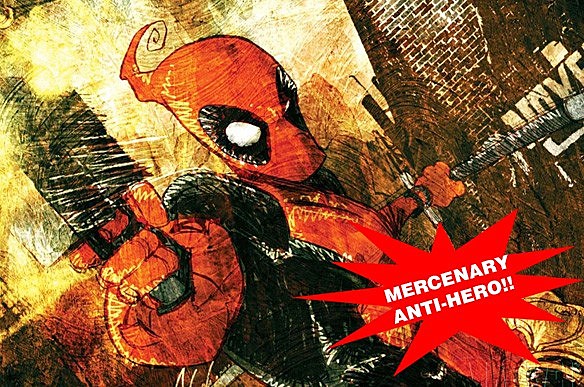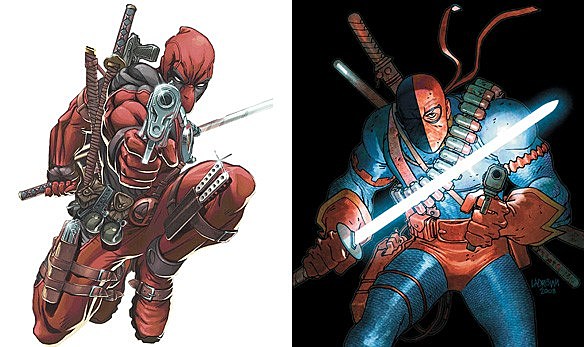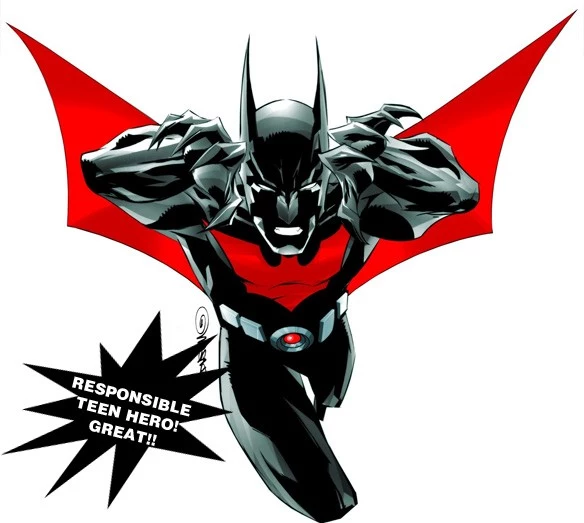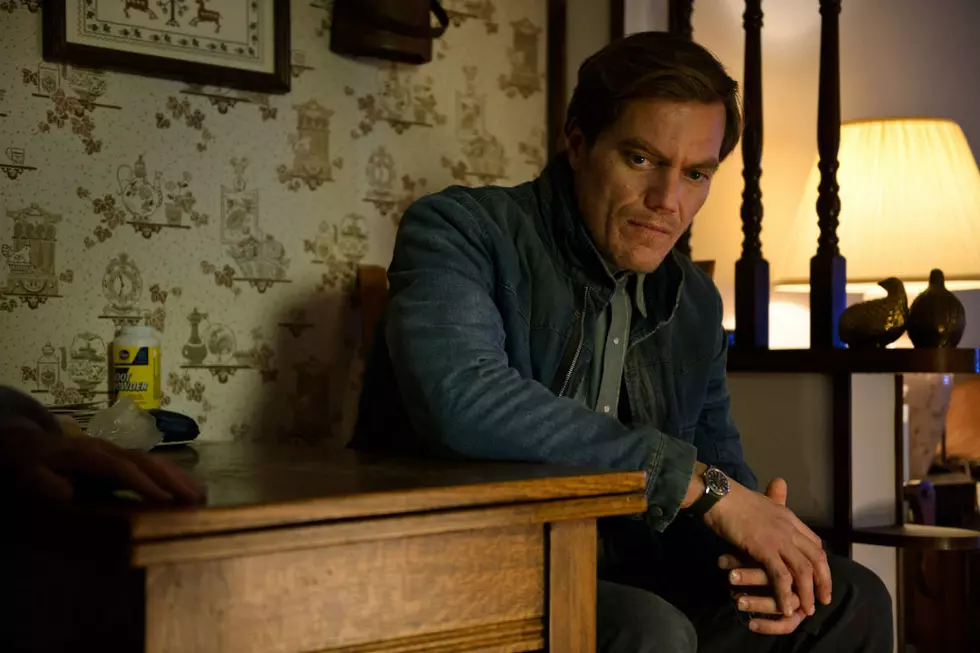
The 5 Greatest Knockoff Characters In Comics

One of the most accepted truisms in super-hero comics is that there's not a whole lot of new stuff to be found underneath Earth's yellow sun. With seventy years of heroes, villains, selfless acts and dastardly schemes, plenty of creators have come up with bold new ideas, only to find out that they were done years ago. Probably by Jack Kirby.
But that's not necessarily a bad thing. A lot of the fun of super-hero comics comes from taking those old elements and seeing a new spin on them. Whether they're obvious and intentional stand-ins -- like The Authority's Apollo and Midnighter as Superman-and-Batman -- or creations that try to slip by unnoticed, there are plenty of bootleg versions of super-heroes out there, and some of them actually become great in their own right. And those are the characters we're spotlighting today with a look at The Top Five Greatest Knockoff Characters In Comics!


The Original: DC's Darkseid
The Tipoff: One's a gigantic evil godlike being with distinctly rough facial features who lives in space with other "gods" and seeks to dominate the universe in pursuit of the opposite of life, and the other's... well, you get the idea.
Back in 1973, Jim Starlin was given the chance to write an issue of Iron Man for Marvel, and he decided that was as good an opportunity as any to introduce a set of characters he'd come up with during a college psychology course. The characters were based on two competing mental concepts that should be familiar to anyone who caught their appearance on The Venture Brothers, and while Eros (named for the sex drive) would take up the name "Starfox" and go on to become the creepiest Avenger, his brother Thanos (shortened from "Thanatos," the self-destructive "death drive") entered the Marvel Universe as a universe-conquering bad guy who bore a striking resemblance to DC's Darkseid, created by Jack Kirby three years earlier.

It's not like they're exactly the same, though. I mean, Darkseid has a miniskirt and Thanos has a shiny golden codpiece. And Thanos is totally into death, while Darkseid is into anti-life! See? Completely different!
Okay, okay, they've got a lot in common. But that wasn't the original plan. While Starlin cops to the fact that Thanos and the rest of the folks on Titan were inspired by the mythology Kirby was building with his New Gods, he also says that his original idea of Thanos was more along the lines of the knowledge-seeking Metron, right down to cruising through space in a chair. The connection between the two was only made when editor Roy Thomas told Starlin to give Thanos a more powerful build, suggesting "If you're going to steal one of the New Gods, at least rip off Darkseid, the really good one!"
With that in place, Thanos pretty much grew into the role, right down to holding a similar position as a cosmic-level tough-guy, something that Kurt Busiek and George Perez referenced in their JLA/Avengers crossover, when Darkseid got his hands on Thanos's signature galaxy-dominating weapon, the Infinity Gauntlet, and decided it just wasn't for him:

But it doesn't stop there. In 1980, Starlin would co-create Mongul with Len Wein, a character that's often treated as DC's version of Thanos, who was Marvel's version of Darkseid. Throw in the Modern Age verison of Despero, and we might actually be dealing with a great-grand-knockoff.


The Original: Nick Fury, Agent of S.H.I.E.L.D.
The Tipoff: Soldiers with super-technological weapons waging a kinda-secret battle against an organization that, for some reason, is always capitalized, and is involved in increasingly ridiculous plots of world domination.
G.I. Joe is, of course, the codename for America's daring, highly-trained special missions force whose purpose is to defend human freedom against COBRA, a terrorist organization determined to rule the world. I mean, c'mon, everybody knows that, right? But before they were the subject of a cartoon and toy line reviving Hasbro's Kung-Fu-Gripping bearded action dolls, the Joes were actually meant for the Marvel Universe.
When Larry Hama created Hawk, Scarlett and Snake-Eyes, his original intent was to provide Marvel with the next generation of the Agents of S.H.I.E.L.D. called the Fury Force. Instead of Hawk, the team would've been led by Nick Fury's kid, and rather than COBRA's attempts to steal Alaska, employ mind-control perfume or take over the fast food industry with nuclear missiles, their opponents were slated to be the slightly scarier neo-Nazis of a resurrected HYDRA:

Marvel passed, but Hama used the premise to provide the storyline for Hasbro's relaunched line of Joe toys, and ended up writing the accompanying comic at Marvel for over 150 issues, although tying into a toy line meant that there were definitely some changes to the original concept. William "The Refrigerator" Perry, for instance, does not exist in Marvel continuity. Seriously. Check the handbooks.


The Original: Deathstroke the Terminator
The Tipoff: Slade Wilson, meet Wade Wilson. You two have a lot to talk about, I'm sure.
Okay, so after a military experiment ends up giving him super-human abilities that can be put to good use stabbing and/or shooting super-heroes, a man named Wilson goes rogue and becomes one of the world's top mercenaries, taking down his targets with an inexplicable (and inefficient) fondness for swords.
If that sounds familiar, that's because it's a pretty solid description of both Marvel's Deadpool and the genuine article he was created in response to: Deathstroke the Terminator.

The fact that Deadpool's a knockoff of the Stroke (as I like to call him) has never really been what you'd call a secret, because really, when you give a guy a name that rhymes with another character's, you might as well give him a sign to carry around. Frankly, I'm surprised that DC didn't respond by having Batman slap around a crooked circus strongman called Beater Barker.
The comparison was even directly acknowledged in 2006's Superman/Batman Annual #1, when the World's Finest faced off against a guy identified as a verison of Deathstroke from an alternate universe:

That story was, of course, written by Joe Kelly, the writer who is also largely responsible for transforming Deadpool from being a generic mutant mercenary to the successful parody he would eventually become.
Deathstroke, meanwhile, continues to parody himself purely by accident.


The Original: Mr. Tawky Tawny
The Tipoff: The hair, the jacket, the tie and the best friend.
Thanks to panels like the one above, I'm of the firm belief that Jimmy Olsen is the single greatest character of the Silver Age, but even he is standing on the shoulders of giants. Or, at the very least, on the shoulders of a talking tiger, because when you get right down to it, Superman's Pal Jimmy Olsen is just an update of Captain Marvel's Pal, Mr. Tawky Tawny.
Introduced in 1947's Captain Marvel Adventures #79, Tawny blazed the trail that Jimmy Olsen would walk down in the '50s and '60s. Not only do the two characters have the same distinctive orange hair, matching checked jackets in various shades of green and brown and a penchant for neckwear, but they were both trouble-magnet sidekicks for incredibly powerful super-heroes, who were themselves considered knockoffs of each other:

The most telling trait, though, comes from the presence of writer Otto Binder, Tawny's creator and the writer most associated with Captain Marvel's Golden Age adventures. While Jimmy Olsen was originally created for the Superman radio show, it wasn't until the comics that he became the iconic representation of Silver Age madness that we all know and love. So who'd they get to write those comics? Otto Binder, who produced multiple stories for over fifty issues of Superman's Pal Jimmy Olsen. Seriously, that dude was way into checked jackets.
And amazingly, despite the fact that DC owns them both, these dudes do not hang out with each other. What gives, DC?


The Original: Spider-Man
The Tipoff: Don't those villains seem awfully familiar?
Batman Beyond, in which a cranky old Bruce Wayne mentors a young successor in a future of flying cars and truly hilarious dance clubs is one of the greatest premises of all time. Seriously, there are like 9 things I love in that sentence. But when it came time to flesh out the details of the next generation of bat-themed vigilantes, the creators borrowed an awful lot from the story of Peter Parker, the Amazing Spider-Man.
Admittedly, the basic premise of a teenager fighting crime and maintaining a secret identity in high school and juggling crime fighting and girl trouble is a solid start for any number of young super-heroes, and even if Spider-Man popularized that gimmick, you can hardly say that it really belongs to him. But then you get to the villains, and you find out that Terry McGinnis's arch-nemesis is an evil industrialist who turns into a murderous green super-villain.

And then you find out that he fought a sinister big game hunter who came to his city in order to prove himself against a different class of prey.

And then you find out that he also fights a criminal bonded to a strange black shape-shifting skin.

And then... well, you get the idea. But like everything else on this list, it worked out. I mean, c'mon: Spider-Man being mentored by Batman? How awesome is that?
More From ComicsAlliance









